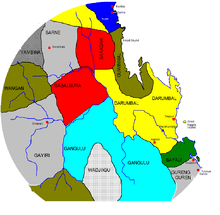Darumbal
The Darumbal (occasionally Dharumbal) are the Indigenous Australians that have traditionally occupied Central Queensland, speaking dialects of the Darumbal language. Darumbal people of the Keppel Islands and surrounding regions are sometimes also known as Woppaburra or Ganumi,[1][2] and the terms are sometimes used interchangeably.
Country

Traditional Darumbal land is considered to encompass an estimated 4,000 square miles (10,000 km2) around most of coastal Central Queensland, running from Arthur Point at Shoalwater Bay to Yeppoon, and taking in the mouth of Fitzroy River and Keppel Islands. From Keppel Bay they extended inland to Boomer Range, and Marlborough, Yaamba, Rockhampton, and Gracemere.[3]
Language
Ethnologue classifies the Darumbal language as "extinct".[4] Technically, Bayali was quite distinct from Darumbal, sharing, according to Dixon's analysis, no more than 21% of its basic word stock with Darumbal.[5]
Society
The Darumbal comprised some 13 hordes, though one of these was described as belonging to the Ningebal tribe. One extinct branch of the group, the Warabal, may have dwelt around the foot of the Boomer Range.[3]
History
With the arrival of European settlers in the region, some Darumbal were tolerated as fringe communities of the new settlements, but most were systematically removed to make way for pastoral development.[6] According to some estimates, "between 1865 and 1902 the population of the Keppel Islands suffered a substantial reduction of 75 to 80 per cent".[1] In one incident alone on July 1865 alone, native troopers ambushed a Darumbal ceremonial gathering outside Rockhampton, near Samuel Birkbeck's Glenmore Station and shot dead 18 Aborigines, after nearby settlers expressed worries about the presence of natives in their area. After the massacre, they then set fire to the corpses.[7][8]
Native title
Darumbal Native Title claims and land use issues have become prominent in recent years. In 2001, a claim was made to the National Native Title Tribunal,[9] and in 2007 137 hectares at Mount Wheeler were handed over to the tribe.[10] There have been several controversies regarding fisheries licensing and conservation.[11][12] Darumbal people have been granted limited access to the Shoalwater Bay Military Training Area.[13]
Although the language is extinct, some Darumbal words live on in place names in Central Queensland. The town of Coowonga is named after a Darumbal man famous for saving the life of politician King O'Malley in the late 19th century.[14] The Rockhampton suburb of Nerimbera is named for a Darumbal word meaning 'where the mountains meet the river'.[15]
Some Darumbal words
- Gudamulli is a Darumbal greeting, meaning 'hello'.[16]
Notes
Citations
- 1 2 Rowland 2004, p. ?.
- ↑ AIATSIS 2005.
- 1 2 Tindale 1974.
- ↑ Ethnologue.
- ↑ Terrill 2002, p. 15.
- ↑ GBRMPA.
- ↑ Kiernan 2007, p. 307.
- ↑ Evans 2012, p. 156.
- ↑ NNTT.
- ↑ QCO.
- ↑ Wratten 2010.
- ↑ Wratten 2011.
- ↑ Indigenous Control of Indigenous Heritage.
- ↑ CSS.
- ↑ Nerimbera Football Club.
- ↑ Conway-Dodd 2015.
Sources
- Bauman, Berylanne (17 October 2011). "Call to stop hunting dugong". Sunshine Coast Daily.
- "'Bayali'". Ethnologue.
- Conway-Dodd, Zhanae (18 December 2015). "Rocky students to learn Darumbal language at school". The Morning Bulletin.
- "CQU hosts successful Darumbal sites tour". Central Queensland University. 25 May 2006.
- "Deadline Approaches on Darumbal Native Title Claim". National Native Title Tribunal.
- "Elder Adoption Ceremony". Coowonga State School. Queensland Government. Archived from the original on 18 February 2014.
- Evans, Raymond (2012). ""Plenty Shoot 'Em": The Destruction of Aboriginal Societies along the Queensland Frontier". In Moses, A. Dirk. Genocide and Settler Society: Frontier Violence and Stolen Indigenous Children in Australian History. Berghahn Books. pp. 150–173. ISBN 978-1-571-81411-1.
- Flowers, W. H. (1956). "Habits, customs and relationships of the Australian Aboriginals". Journal of the Royal Historical Society of Queensland. 5 (4): 1254–1262.
- "Gumoo Woojabuddee Section Fact Sheets" (pdf). Great Barrier Reef Marine Park Authority.
- "Indigenous Control of Indigenous Heritage". Australian Department of the Environment and Heritage.
- Kiernan, Ben (2007). Blood and Soil: A World History of Genocide and Extermination from Sparta to Darfur. Yale University Press. ISBN 978-0-300-10098-3.
- "Mt Wheeler handed over to traditional Darumbal owners in historic ceremony". Queensland Cabinet Office.
- "Nerimbera Football Club".
- Roth, Walter E. (15 November 1910). "North Queensland Ethnography: Social and individual nomenclature" (PDF). Records of the Australian Museum. Australian Museum. 8 (1): 79–106.
- Rowland, Michael (2004). "Myths and non‐myths: Frontier 'massacres' in Australian history — the Woppaburra of the Keppel Islands". Journal of Australian Studies. 28 (81): 1–16.
- Terrill, Angela (2002). Dharumbal: the language of Rockhampton. Research School of Pacific and Asian Studies. ISBN 978-0-858-83462-0.
- Tindale, Norman Barnett (1974). "Darambal (QLD)". Aboriginal Tribes of Australia: Their Terrain, Environmental Controls, Distribution, Limits, and Proper Names. Australian National University Press. ISBN 978-0-708-10741-6.
- "Title case opens in national park" (PDF). AIATSIS. March 2005.
- Wratten, Adam (12 February 2010). "Darumbal Man Appeals $2000 fine". The Morning Bulletin.
- Wratten, Adam (16 September 2011). "Hunter Rejects Dugong Ban Call". The Morning Bulletin.